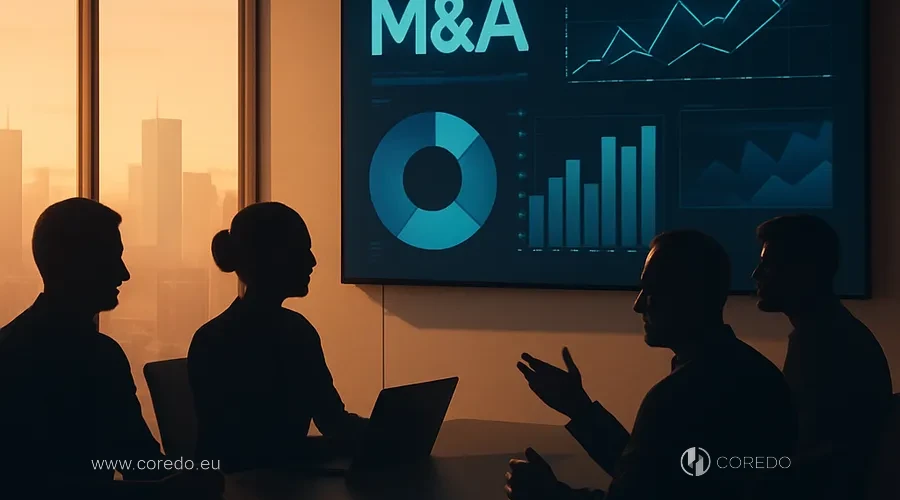Private equity and M&A deals play a key role in the strategy of funds seeking to increase their returns and achieve meaningful capital growth. By investing in private companies and revaluing businesses through mergers and acquisitions, funds gain flexible tools for scaling and diversifying the portfolio.
These directions allow funds to effectively use market opportunities – below we will look at what private equity is and how the respective funds operate.
What is private equity and how do funds operate
private equity funds accumulate capital from institutional and private investors, forming a portfolio of companies with high growth potential. The key task is to implement private equity strategies that provide asset value growth and maximize returns with a controlled level of risk.
In COREDO’s practice we observe that successful private equity funds build their strategies on deep industry analysis, the search for undervalued assets, active management and the use of modern financial modeling tools.
M&A in private equity strategy: buyout and growth capital
Private equity M&A deals are not just a tool for buying or selling a business. They become the basis for executing buyout deals (purchase of a controlling stake), attracting growth capital (capital for growth), as well as for carve-out deals (the separation of non-core divisions). Each of these approaches requires a unique set of skills and a deep understanding of the market.
A COREDO-executed buyout case in the fintech sector in the Czech Republic showed: a structured deal with clear post-merger integration allowed increasing the portfolio company’s EBITDA by 38% in 18 months.
Carve-out deals, on the contrary, are often used to optimize a holding’s structure and free up capital for new investments.
Objectives of M&A deals for private equity: growth and synergies
The key objective is to ensure fund return growth by increasing the value of portfolio companies. This is achieved through the realization of synergies (for example, procurement optimization, consolidation of IT platforms, improving operational efficiency), as well as scaling the business through M&A.
COREDO’s practice confirms: it is post-merger integration and competent management of synergies that determine the success of a deal over a 3–5 year horizon.
Private equity strategies in M&A to increase returns

Private equity strategies in M&A to increase returns become a key tool for boosting profits and creating long-term value for the investor. Funds use structured approaches to selecting target companies and actively implement analytical risk management methods to maximize the financial return of each project. Next, let’s consider the roll-up strategy as one of the effective ways to increase returns within M&A.
Roll-up strategy: risks and opportunities
The roll-up strategy is the sequential consolidation of companies within one industry with the goal of creating a market leader and increasing EBITDA multiples. This approach allows for rapid market share growth, cost optimization, and increasing bargaining power with suppliers and customers.
The key success factor is a clear integration roadmap and risk management through phased integration.
Bolt-on acquisitions and carve-outs to scale
Bolt-on acquisitions: these are acquisitions that complement an existing platform company of the fund. This approach allows for quickly expanding the product line, strengthening positions in niche segments, and increasing business resilience. Carve-out deals, by contrast, provide the opportunity to acquire a mature business with a clear structure but without excessive corporate overhead.
A solution developed at COREDO for a client in the payment services sector in Slovakia included a bolt-on acquisition of a startup with a unique KYC technology. This allowed not only to accelerate entry into new markets, but also to significantly increase the company’s valuation at the subsequent exit stage.
Buyer-led M&A and the role of operating partners in integration
Buyer-led M&A: a strategy in which the initiative and control over the deal process are fully concentrated on the buyer’s side. In modern conditions, the success of such a strategy is impossible without involving operating partners (operating partners), who take on key tasks for managing integration after the merger.
This is especially relevant for deals in fintech and digital health, where integration speed directly affects return growth.
Return and risk assessment in M&A and private equity deals

Return and risk assessment in M&A PE deals are key aspects that determine the success and sustainability of investing in private equity. A well-structured deal allows not only increasing profitability but also minimizing risks, which is especially important in conditions of high market uncertainty. Next, we will examine the main metrics, such as ROI and EBITDA, used to evaluate the effectiveness of such deals.
Metrics, ROI and EBITDA in private equity deals
Assessment of ROI in private equity deals is based on analysis of IRR (internal rate of return), EBITDA multiples, as well as calculations of cash-on-cash return and MOIC (multiple on invested capital).
At COREDO we use a comprehensive model for assessing investment returns, considering both financial and non-financial KPIs – from integration speed to key employee retention rates.
For M&A deals in Europe and Asia, EBITDA multiples in the range of 7–12x become the standard; on the other hand, for high-tech companies this metric can exceed 15x. It is important to take into account industry benchmarks and market dynamics.
Risk management in M&A: due diligence and compliance
Effective risk management in M&A begins with thorough Due Diligence, financial, legal, operational and technological. AML and KYC standards, as well as compliance requirements in the EU, the UK, Singapore and Dubai, are becoming increasingly strict.
Regulatory changes, for example the tightening of AML in the EU rules or the introduction of new requirements for licensing financial services in Singapore, significantly affect deal structures and their closing timelines. In such circumstances it is critically important to work with consultants who possess expertise in cross-border deals.
Impact of macroeconomics and interest rates on M&A and private equity deals
In 2024–2025, rising interest rates and higher borrowing costs changed the financing structure of M&A deals. Funds now more often use private credit, mezzanine and other alternative sources to maintain target return levels.
At COREDO we recommend structuring deals flexibly, taking into account macroeconomic trends and potential market volatility.
Technology in M&A for private equity

Technology in M&A for private equity is becoming a key factor for successful deals and competitive advantage. Modern solutions – from artificial intelligence to integrated platforms – enable private equity funds to accelerate processes, reduce risks and find new growth opportunities.
Use of AI and platforms to accelerate deals
Modern technological platforms for M&A, such as virtual data rooms, tools for automating due diligence and artificial intelligence for risk assessment, can speed up the deal process by 30–40%.
At COREDO we implement AI solutions for analyzing large datasets, identifying hidden risks and building integration scenarios.
AI tools are especially in demand for assessing synergies, automating financial modeling and monitoring post-merger integration. Such solutions are becoming standard for private equity funds focused on increasing returns and reducing transaction costs.
Agile teams and managing integration after a merger
Agile approaches to managing post-merger integration allow quick adaptation to changes, minimize operational disruptions and accelerate the realization of synergies. In COREDO’s practice, agile teams take on key responsibilities for communication, change management and implementing new business processes.
This approach is particularly effective for deals in fast-growing sectors – fintech, e-commerce, healthcare.
Cross-border M&A in private equity for Europe, Asia and the CIS

Cross-border M&A in private equity for Europe, Asia and the CIS opens new opportunities for investors, but requires a deep understanding of the specifics of transactions between different regions. The combination of global strategies and local particularities creates many regulatory and structural nuances that must be taken into account to successfully carry out such deals.
Regulatory nuances of deals in different jurisdictions
Cross-border transactions require deep knowledge of local regulatory requirements, licensing procedures and compliance standards. In the EU, the United Kingdom, Singapore and Dubai there are different approaches to due diligence, deal structure and investor protection.
COREDO’s experience in supporting cross-border M&A shows: deal success largely depends on the right choice of structure (SPV, holding, trust), as well as on timely obtaining the necessary licenses.
Particular attention should be paid to changes in the regulatory environment: for example, new EU directives on AML, disclosure requirements in the UK and licensing standards for fintech companies in Singapore.
Impact of geopolitics and culture on deals and integration
geopolitical risks and cultural differences can significantly affect deal closing timelines, governance structure and the effectiveness of post-merger integration. At COREDO we take these factors into account when structuring deals in Asia and Europe, developing individual integration and communication scenarios for each jurisdiction.
Features of cross-border M&A in private equity funds for European and Asian markets include differences in corporate culture, approaches to personnel management and reporting standards. Successful integration requires not only legal expertise but also a deep understanding of local business.
Financing models for M&A during market volatility
In conditions of market volatility and rising capital costs, private equity funds increasingly use alternative financing models: private credit, mezzanine, structured deals with deferred payment and earn-out mechanisms.
COREDO solutions enable flexible structuring of deals, minimizing risks and optimizing tax nload.
Structuring deals taking into account the requirements of different jurisdictions and opportunities for tax optimization becomes a key success factor for cross-border M&A.
Exit strategies and liquidity in private equity through M&A

Exit strategies and liquidity in private equity through M&A play a key role in shaping returns for investors and determine how funds realize accumulated value. Properly chosen exits — whether an IPO, sale to a strategic investor, or a secondary buyout — provide the necessary liquidity and maximize the profitability of each investment.
Exit strategies: IPO, sale and secondary buyouts
Providing liquidity: one of the main tasks of private equity funds. The most common exit strategies include IPOs, sales to strategic investors, and secondary buyouts. Each of these options requires careful preparation and consideration of market conditions.
COREDO’s practice shows: successful exits are built on deep market analysis, preparing the company for sale (exit readiness), and developing alternative scenarios. Secondary buyouts and deals with financial investors are especially relevant in conditions of high market volatility.
Planning and managing an asset portfolio for returns
Exit planning begins long before the deal itself. At COREDO we recommend implementing a KPI system to assess deal performance, regularly revaluing the portfolio, and preparing companies for a potential IPO or sale. Assessing investment returns is based not only on financial metrics but also on analysis of operational efficiency, customer retention levels, and innovation potential.
Portfolio asset management is an ongoing process that includes optimizing structure, implementing new technologies, and developing team competencies.
Recommendations for entrepreneurs and investors
- Clearly define the deal objectives and choose an M&A strategy based on industry trends and market specifics.
- Implement modern risk management methods: comprehensive due diligence, monitoring regulatory changes, dynamic compliance.
- Use technology platforms and AI to accelerate deals, automate data analysis, and assess synergies.
- Form agile teams and engage operating partners for effective post-merger integration.
- Work with international advisers who have experience supporting cross-border deals and deep knowledge of local markets.
COREDO’s experience confirms: a systemic approach to M&A, based on data analysis, technological innovation, and human capital management, not only reduces risks but also ensures sustainable growth in private equity fund returns.
M&A in private equity: key conclusions and outlook
Increasing private equity returns through M&A is the result of comprehensive work: from choosing the right strategy to implementing innovations and managing integration. In 2025, the key trends will be digital transformation, AI development, tightening regulatory requirements, and the growing role of operating partners.
For entrepreneurs and investors focused on international markets, partnering with experts who can provide comprehensive support at all stages of a deal becomes critically important.
If your goal is not just to complete a deal but to build a sustainable and scalable business, the COREDO team is ready to become your strategic partner on this journey.
Comparison of M&A strategies: roll-up, bolt-on, carve-out
| Strategy | Risks | Returns | Applicability |
|---|---|---|---|
| Roll-up | Integration issues, overestimation of synergies | High | Industry consolidation, rapid growth |
| Bolt-on | Cultural integration, technological incompatibilities | Medium–high | Platform expansion, new markets |
| Carve-out | Asset valuation, regulatory barriers | Medium | Structure optimization, new niches |
ROI and KPIs for deal evaluation
- IRR (internal rate of return)
- EBITDA multiples
- Cash-on-cash return
- MOIC (multiple on invested capital)
- Integration speed
- Key staff retention rate
- Revenue and EBITDA growth after the deal
Glossary of SEO terms
- Private equity: direct investments in private companies.
- M&A (mergers and acquisitions), mergers and acquisitions.
- Buyout – acquisition of a controlling stake.
- Roll-up strategy: consolidation of companies within an industry.
- Bolt-on acquisition: an additional acquisition to a platform company.
- Carve-out – spinning off a division into an independent business.
- Operating partner – an operating partner managing integration.
- Due diligence, comprehensive assessment of the deal target.
- EBITDA: earnings before interest, taxes, depreciation and amortization.
- Compliance: adherence to regulatory requirements.
- Exit strategy, a way to exit investments (sale, IPO, secondary buyout).
If you plan to use M&A to increase returns in private equity, start with a systematic analysis, choose a strategy that matches your goals, and engage COREDO experts for comprehensive support at every stage of the deal.